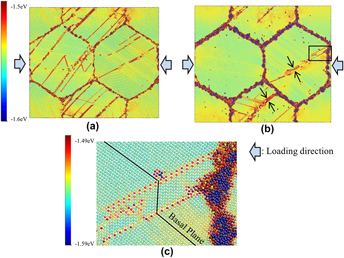Crossref Citations
This article has been cited by the following publications. This list is generated based on data provided by
Crossref.
Groh, Sébastien
2016.
Modified embedded-atom potential for B2-MgAg.
Modelling and Simulation in Materials Science and Engineering,
Vol. 24,
Issue. 6,
p.
065011.
Zhang, Zhenyu
Huang, Siling
Chen, Leilei
Wang, Bo
Wen, Bin
Zhang, Bi
and
Guo, Dongming
2017.
Ultrahigh hardness on a face-centered cubic metal.
Applied Surface Science,
Vol. 416,
Issue. ,
p.
891.
Karewar, S.
Gupta, N.
Groh, S.
Martinez, E.
Caro, A.
and
Srinivasan, S.G.
2017.
Effect of Li on the deformation mechanisms of nanocrystalline hexagonal close packed magnesium.
Computational Materials Science,
Vol. 126,
Issue. ,
p.
252.
Namakian, Reza
and
Voyiadjis, George Z.
2018.
An atomic displacive model for101¯21¯011twinning in hexagonal close packed metals with the emphasis on the role of partial stacking faults in formation of{101¯2}twins.
Acta Materialia,
Vol. 150,
Issue. ,
p.
381.
Groh, Sébastien
and
Nahhas, Mohammad K.
2018.
Handbook of Mechanics of Materials.
p.
1.
Nahhas, M.K.
and
Groh, S.
2018.
Atomistic modeling of grain boundary behavior under shear conditions in magnesium and magnesium-based binary alloys.
Journal of Physics and Chemistry of Solids,
Vol. 113,
Issue. ,
p.
108.
Groh, Sébastien
and
Nahhas, Mohammad K.
2019.
Handbook of Mechanics of Materials.
p.
331.
Gao, Feng
Yang, Qi
Du, Jiguang
and
Jiang, Gang
2020.
Atomistic investigation on effect of Ca doping ratio on mechanical behaviors of nanocrystalline Mg-Ca alloys.
Journal of Molecular Modeling,
Vol. 26,
Issue. 5,
Namakian, Reza
Voyiadjis, George Z.
and
Kwaśniak, Piotr
2020.
On the slip and twinning mechanisms on first order pyramidal plane of magnesium: Molecular dynamics simulations and first principal studies.
Materials & Design,
Vol. 191,
Issue. ,
p.
108648.
Miyazawa, Naoki
Suzuki, Shunya
Hakamada, Masakata
and
Mabuchi, Mamoru
2020.
Atomic Simulations of Interactions between Edge Dislocations and a Twist Grain Boundary in Mg.
MATERIALS TRANSACTIONS,
Vol. 61,
Issue. 6,
p.
1063.
Yu, Shilun
Wan, Yingchun
Liu, Chuming
Chen, Zhiyong
and
Zhou, Xiangyang
2021.
Twinning-Induced Abnormal Strain Rate Sensitivity and Indentation Creep Behavior in Nanocrystalline Mg Alloy.
Materials,
Vol. 14,
Issue. 22,
p.
7104.
Kapan, Enver
Alkan, Sertan
Can Aydıner, C
and
K Mason, Jeremy
2023.
Energetic contributions to deformation twinning in magnesium.
Modelling and Simulation in Materials Science and Engineering,
Vol. 31,
Issue. 7,
p.
075002.
Liu, Beibei
Guo, Long
Chen, Yangchun
Li, Xiaofan
Wang, Kun
Deng, Huiqiu
Hu, Wangyu
Xiao, Shifang
and
Yuan, Dingwang
2024.
Role of micro-alloying element in dynamic deformation of Mg-Y alloys.
International Journal of Mechanical Sciences,
Vol. 269,
Issue. ,
p.
109057.
 $\left\{ {10\bar 12} \right\}$ and
$\left\{ {10\bar 12} \right\}$ and  $\left\{ {10\bar 11} \right\}$ twinning in Mg
$\left\{ {10\bar 11} \right\}$ twinning in Mg
 $\left[ {11\bar 20} \right]$-textured 2-dimensional polycrystalline pure Mg, Mg–0.1 at.%Al, and Mg–1.0 at.%Al models were performed at 5 and 300 K. A
$\left[ {11\bar 20} \right]$-textured 2-dimensional polycrystalline pure Mg, Mg–0.1 at.%Al, and Mg–1.0 at.%Al models were performed at 5 and 300 K. A  $\left\{ {10\bar 11} \right\}$ twin nucleated before formation of a
$\left\{ {10\bar 11} \right\}$ twin nucleated before formation of a  $\left\{ {10\bar 12} \right\}$ twin in the simulations at 5 K, while a
$\left\{ {10\bar 12} \right\}$ twin in the simulations at 5 K, while a  $\left\{ {10\bar 11} \right\}$ twin nucleated after formation of a
$\left\{ {10\bar 11} \right\}$ twin nucleated after formation of a  $\left\{ {10\bar 12} \right\}$ twin in the simulations at 300 K. The formation of a
$\left\{ {10\bar 12} \right\}$ twin in the simulations at 300 K. The formation of a  $\left\{ {10\bar 11} \right\}$ twin was the result of the glide of pyramidal 〈c + a〉 partial dislocations of
$\left\{ {10\bar 11} \right\}$ twin was the result of the glide of pyramidal 〈c + a〉 partial dislocations of  ${1 \mathord{\left/ {\vphantom {1 6}} \right. \kern-\nulldelimiterspace} 6}\left\{ {10\bar 11} \right\}\left[ {\bar 2023} \right]$.
${1 \mathord{\left/ {\vphantom {1 6}} \right. \kern-\nulldelimiterspace} 6}\left\{ {10\bar 11} \right\}\left[ {\bar 2023} \right]$.  $\left\{ {10\bar 11} \right\}$ twin formation was suppressed at the sites around the Al atoms because the strong Mg–Al bond suppresses atomic shuffling. However, formation was not suppressed at the sites away from the Al atoms because the effect of strong Mg–Al bond is short range. On the other hand, because
$\left\{ {10\bar 11} \right\}$ twin formation was suppressed at the sites around the Al atoms because the strong Mg–Al bond suppresses atomic shuffling. However, formation was not suppressed at the sites away from the Al atoms because the effect of strong Mg–Al bond is short range. On the other hand, because  $\left\{ {10\bar 12} \right\}$ twinning requires the simultaneous glide of zonal dislocations, Al inevitably suppressed
$\left\{ {10\bar 12} \right\}$ twinning requires the simultaneous glide of zonal dislocations, Al inevitably suppressed  $\left\{ {10\bar 12} \right\}$ twinning.
$\left\{ {10\bar 12} \right\}$ twinning.